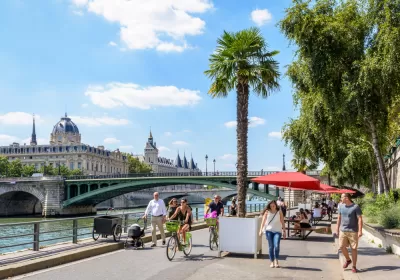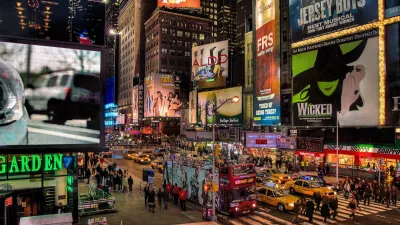The concept, touted as "hyper-local," can fail to take into account local conditions and historical inequities in American cities.

The concept of the "15-minute city" has been adopted as an aspirational buzzword by city leaders across the United States, but "there are dangers of applying a model conceived in Europe to many North American cities," writes Feargus O'Sullivan for Bloomberg CityLab. Urban designer Jay Pitter calls transplanting the idea potentially "presumptive and colonial," arguing that "it doesn't take into account the histories of urban inequity, intentionally imposed by technocratic and colonial planning approaches, such as segregated neighborhoods, deep amenity inequity and discriminatory policing of our public spaces" that are deeply embedded in American cities.
European cities, designed before mass car ownership, are more well-suited to the notion of the 15-minute city, writes O'Sullivan. The lofty goal of creating small neighborhoods where all amenities are within easy reach is "unlikely to reach all neighborhoods in many cities without drastic interventions and investments," and "simply injecting design changes such as bike lanes and parklets into a neighborhood will not reverse segregation that has been embedded into city planning."
The proposals neglect "a century of planning interventions that have actually concretized deep social divisions between people," says Pitter, calling the concept "top-down, technocratic urban planning" rather than a "systematic and holistic approach" that would more carefully consider social relationships and historic inequities. While it claims to be hyper-local, Pitter argues that implementing the approach without consideration to local conditions has the opposite effect.
FULL STORY: Where the ‘15-Minute City’ Falls Short

Study: Maui’s Plan to Convert Vacation Rentals to Long-Term Housing Could Cause Nearly $1 Billion Economic Loss
The plan would reduce visitor accommodation by 25,% resulting in 1,900 jobs lost.

North Texas Transit Leaders Tout Benefits of TOD for Growing Region
At a summit focused on transit-oriented development, policymakers discussed how North Texas’ expanded light rail system can serve as a tool for economic growth.

Why Should We Subsidize Public Transportation?
Many public transit agencies face financial stress due to rising costs, declining fare revenue, and declining subsidies. Transit advocates must provide a strong business case for increasing public transit funding.

How Community Science Connects People, Parks, and Biodiversity
Community science engages people of all backgrounds in documenting local biodiversity, strengthening connections to nature, and contributing to global efforts like the City Nature Challenge to build a more inclusive and resilient future.

Alabama: Trump Terminates Settlements for Black Communities Harmed By Raw Sewage
Trump deemed the landmark civil rights agreement “illegal DEI and environmental justice policy.”

Dear Tesla Driver: “It’s not You, It’s Him.”
Amidst a booming bumper sticker industry, one writer offers solace to those asking, “Does this car make me look fascist?”
Urban Design for Planners 1: Software Tools
This six-course series explores essential urban design concepts using open source software and equips planners with the tools they need to participate fully in the urban design process.
Planning for Universal Design
Learn the tools for implementing Universal Design in planning regulations.
City of Santa Clarita
Ascent Environmental
Institute for Housing and Urban Development Studies (IHS)
City of Grandview
Harvard GSD Executive Education
Toledo-Lucas County Plan Commissions
Salt Lake City
NYU Wagner Graduate School of Public Service





























